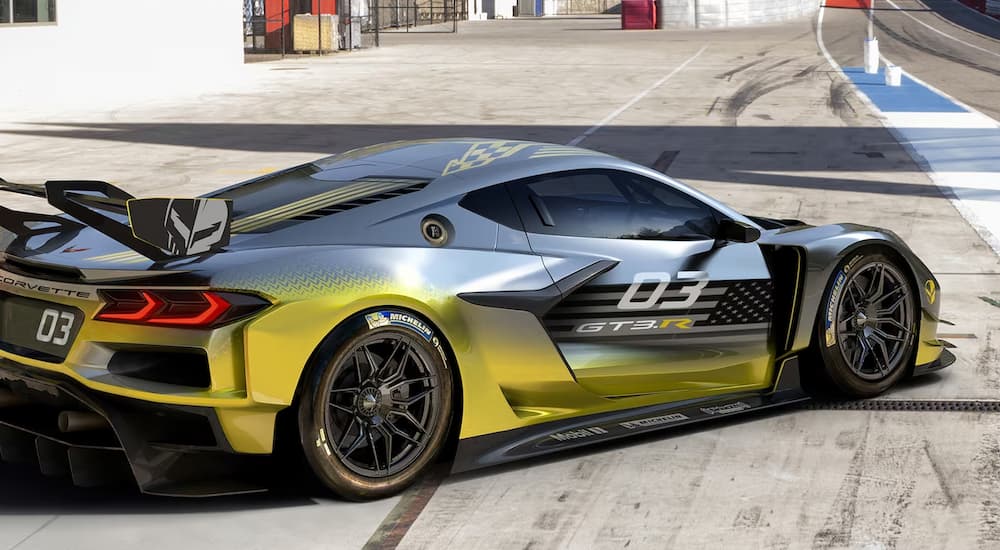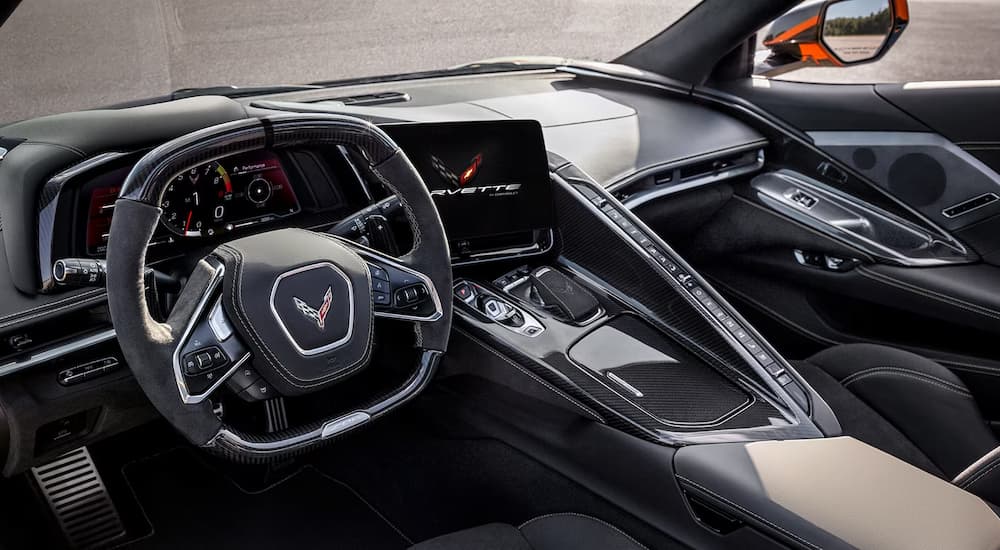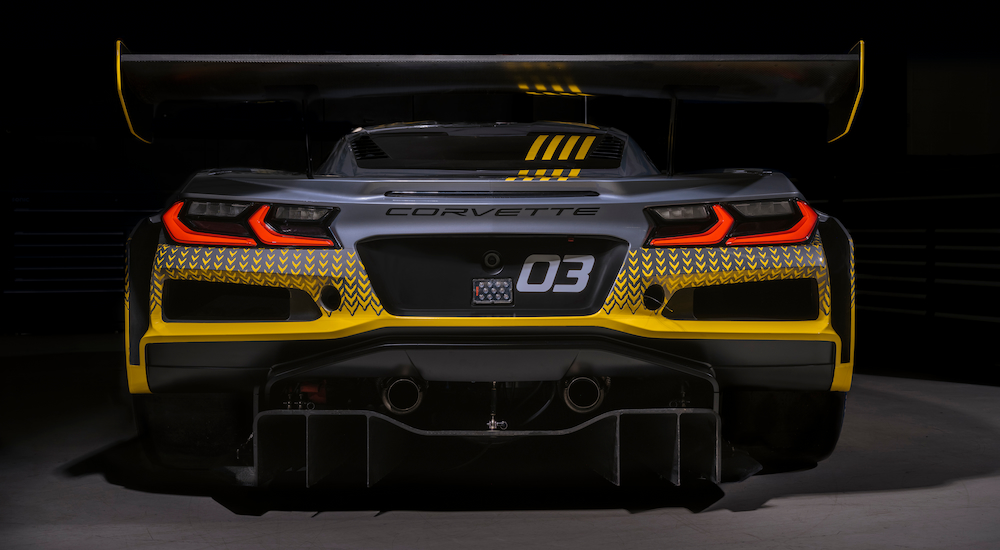Step into your local Chevy dealer, take a quick look at the Chevy Corvette, and one thing immediately becomes clear. This is a car that wants to go fast. Introduced in 1953, the Corvette has been lauded as one of the country’s most original sports car creations. From its recognizable fiberglass bodywork to the famous checkered flag logo, the Corvette has captured the imagination of the driving public for more than six decades.
While the Corvette’s street-legal iterations are a thrill on their own, the sports car has also found considerable success on the track with Chevy’s Corvette Racing Division, racking up an impressive resume since debuting in 1999. This includes nine victories at the 24 Hours of Le Mans, four victories at the 24 Hours of Daytona, and a long list of championships in the FIA World Endurance Championship, IMSA SportsCar Championship, and American Le Mans Series.
That said, Corvette Racing came to an end after the 2023 season, at least in its current form. From 2024 onward, Michigan-based Pratt Miller Motorsports will take on the Corvette Racing mantle, competing in various GT3 Group series like the IMSA SportsCar Championship and FIA World Endurance Championship under the name “Corvette Racing by Pratt Miller Motorsports.” The reorganization does come with a few subtle changes, as GM will be less involved in actual race operations. Pratt Miller Motorsports will still receive plenty of factory support in the new venture, especially when it comes to the car itself.
For the 2024 racing season, Chevy will roll out a new, high-performance version of the Corvette Z06 dubbed the Corvette Z06 GT3.R. Scheduled to make its debut at the 2024 Rolex 24 at Daytona, the same race where Corvette Racing got its start back in 1999, the Z06 GT3.R is the first Corvette to pass the FIA’s strict regulations for the GT3 racing series. With the demise of Chevy’s in-house Corvette Racing team and the arrival of the new Corvette Z06 GT3.R, we thought it would be a good time to refresh ourselves on the Corvette’s on-track history and look ahead to what the future might hold for Corvette Racing by Pratt Miller Motorsports and the new race-ready Corvette. Climb behind the wheel as we delve into the Corvette’s considerable success and see what sort of goodies the Z06 GT3.R has in store. Just don’t bump your head on the roll cage.
A GT Juggernaut
Founded in 1999, Corvette Racing might be a relative newcomer to the scene, but Chevy has been supporting various Corvette racing programs as far back as the early 1960s. Corvette Racing has racked up plenty of success in its 20-plus years, with 122 victories to its name. With 14 Manufacturer’s and Driver’s championships and 15 Team titles under its belt, few teams have been able to match Corvette Racing’s success over the years.
Given Corvette Racing’s considerable success over the years, you might be asking, why was such a significant name in the world of sports cars so late to arrive on the racing scene? After all, the Corvette has been around in one form or another for sixty years but lacked a factory-backed team until just before the turn of the millennium. It all comes down to an infamous resolution passed by the Automotive Manufacturers Association (AMA) in 1957.
The AMA, of which GM was a member, passed a resolution that required all participating automakers to place less emphasis on a model’s performance and racing credentials in their advertisements. This move was spurred, in part, by several high-profile accidents that claimed the lives of drivers and spectators alike, including a particularly grisly incident at the 1955 24 Hours of LeMans that led to 80 deaths. The AMA’s resolution upset the traditional “win on Sunday, sell on Monday” marketing approach that had helped brands to move so many sports cars and fund their in-house race teams, leading brands like GM to reassess their racing operations. Initially, GM resisted the resolution, but public sentiment and an impending antitrust investigation by the U.S. government saw the brand bow to the pressure and shutter its official racing division in the early 1960s.
Chevy managed to resist the lure of the international racing scene for a good 30 years, but that all changed when the fifth-generation (C5.R) Corvette was introduced in 1997. Chevy called on Pratt Miller Engineering to serve as the managing entity, and Corvette Racing was born, giving the beloved sports car its long-awaited moment in the sun. The Corvette Racing team seized on the opportunity, besting the competition to become one of the winningest teams of its time.
The 1999 Rolex 24 at Daytona would be Corvette Racing’s coming-out party, with the team eventually earning 31 victories in the American Le Mans Series’ (ALMS) GT1 class. The team would also find success at the ALMS spiritual home at the actual LeMans race, including wins in 2002 and 2004. The C7.R, which hit the streets in 2005, would notch one of the team’s most impressive records to date, winning 12 straight races in the 2007 through 2009 seasons. The C7.R would be the Corvette’s last front-engine model and one of its less notable in terms of wins when compared to the high-flying early 2000s. Still, the seventh-gen model would earn 17 victories, including a 2015 win at LeMans.
Reviving an Icon
That brings us to Chevy’s latest high-octane creation in the Corvette Z06 GT3.R race car. Developed in partnership with GM Competition Motorsport’s Engineering division and Pratt Miller Engineering, the GT3.R is the first mid-engine Corvette in the brand’s history, and the first mid-engine GM model since 1984’s Pontiac Fiero. Inspired by the Corvette Z06, the Corvette Z06 GT3.R adds a full suite of high-end components into the mix to provide drivers with a ready-made racer that’s poised for success in the ultra-competitive GT3 series.
The journey to building the Z06 GT3.R involves a bit of a road trip. It all starts with the Z06 GT3.R’s chassis, an all-aluminum design that maximizes both strength and durability. Produced at Chevy’s Kentucky-based Bowling Green Assembly Plant, the chassis is then shipped to Pratt Miller HQ in Michigan, where the team installs a custom steel roll cage and a side-impact crash structure composed of carbon fiber, Kevlar, and aluminum. This added protection is a vital safety feature in the GT3 series races, where speeds can reach almost 200 mph, but it’s far from being the Z06 GT3.R’s only upgrade.
Engineers have also outfitted the Corvette with a double-wishbone suspension in the front and rear, which goes a long way towards improving the race car’s handling and stability when cornering and braking. The design also allows race teams to make important adjustments and fit larger, race-specific tires, but these innovations aren’t limited to the souped-up GT3.R version. The standard Z06 features the same double-wishbone suspension design, giving drivers a chance to experience a real racing suspension during their everyday driving.
Shared double-wishbone suspension aside, the Z06 GT3.R does get some substantial upgrades when compared to the base Z06. These include race springs and dampers, heavy-duty brake rotors, calipers and pads, and an advanced aero package that fits the race car with a carbon fiber splitter and diffuser designed to improve the Z06 GT3.R’s downforce, drag reduction, stability, and cooling. Speaking of cooling, the Corvette has also been graced with high-capacity air intakes that are fed through side air ducts and a new hood opening not found on the base Z06. With a little extra room to breathe, the Z06 GT3.R has no problem keeping its radiator, engine, transaxle, and rear brakes within the recommended temperature range for high-performance applications.
One Corvette to Rule Them All
How does the Z06 GT3.R stack up against the competition? The racer is powered by a 5.5L LT6 V8 from Chevy’s Performance Build Center, which made its first appearance in the Corvette’s C8.R iteration. That’s certainly not a bad starting point for the Z06 GT3.R, especially when you consider that the LT6 holds the distinction of being the most powerful naturally aspirated V8 engine ever installed in a road car. The Z06 GT3.R’s LT6 engine shares 70 percent of its parts with the standard Z06, including the crankshaft, cylinder heads, and fuel injectors, but that other 30 percent makes all the difference. Chevy swapped out many of the Z06’s heavier components for lightweight alternatives when building the Z06 GT3.R, resulting in a curb weight that’ll probably tip the scales at less than 2,800 pounds, a factor that should give the race car an impressive power-to-weight ratio.
“There were valuable lessons learned during the C5.R through C7.R programs that aided in the development of our V8 engines for production and racing, many dealing with efficiency, materials, and light-weighting,” said Russ O’Blenes, director of Chevy’s Performance and Racing Propulsion Team. “The flow of information from Corvette Racing to production engineering and back has helped us build race and street-car engines that are fast, reliable, and efficient.”
Only time will tell how the Z06 GT3.R will hold up on the track, but it’s off to a good start and should have little trouble keeping pace with some other automaker’s GT3 models. Take the Ford Mustang GT3, for example. New for the pony car’s seventh generation, the Mustang GT3 features a 5.4L engine based on the automaker’s Coyote V8. In its non-racing form, the Mustang’s Coyote V8 can churn out some 480 horsepower and 415 lb-ft of torque (486 horses and 481 lb-ft when springing for the performance exhaust), and the GT3 is expected to be even more of a beast.
Those numbers should put the Mustang in close competition with the new Z06 GT3.R, though if we’re being honest, horsepower and torque aren’t the be-all, end-all when it comes to racing series like GT3. That’s because GT3 regulations require all participating vehicles to limit their output to between 500 and 600 horsepower. This limitation makes other components, and, of course, the driver’s skill, a much more important part of the equation, allowing all race teams to compete on a more even footing.
Drive Fast
Teams racing in the Corvette Z06 GT3.R will have one major advantage over the competition in the form of Chevy’s aftermarket support. The automaker has launched a new customer support program that will see Chevy operate a parts truck at GT3 Group events around the globe. Outfitted with all the spare parts a racing team could need, including internal components, bodywork, and more, these parts trucks should come in clutch and give Corvette-based drivers an important safety net when things go wrong.
Chevy’s support isn’t limited to just parts. Corvette Racing and GM Motorsports engineers will also be on hand at GT3 events to provide plenty of technical support, from pre-race documentation and chassis setup to post-race documentation, data analysis, and more. With this simple move, Chevy has injected a level of professionalism into the GT3 scene that’s sure to make the brand’s Z06 GT3.R the envy of the rest of the paddock.
While Corvette Racing may be shaking up its organizational structure, the proven race team is far from taking its last lap. Under the leadership of longtime collaborator Pratt Miller Motorsports, Corvette Racing should continue to rack up the wins thanks in no small part to the new Corvette Z06 GT3.R. No matter who’s behind the wheel, be it a professional driver or a passionate amateur out at their local track day, the Corvette is designed to thrill, offering the sort of driving experience that’s difficult to replicate. The performance-minded Z06 GT3.R takes this excitement to the extreme, though the $735,000 starting price will probably see sales limited to racing teams and well-heeled collectors. That said, there are plenty of Corvette models on offer that can come close to replicating the GT3.R experience at a fraction of the price. The Corvette Z06 is still an investment at a little over $110,000, but the entry-level 1LT Coupe can be had for less than $70,000. It might lack the LeMans-winning pedigree of the Z06 GT3.R, but it’s still a Corvette in all the ways that count.







